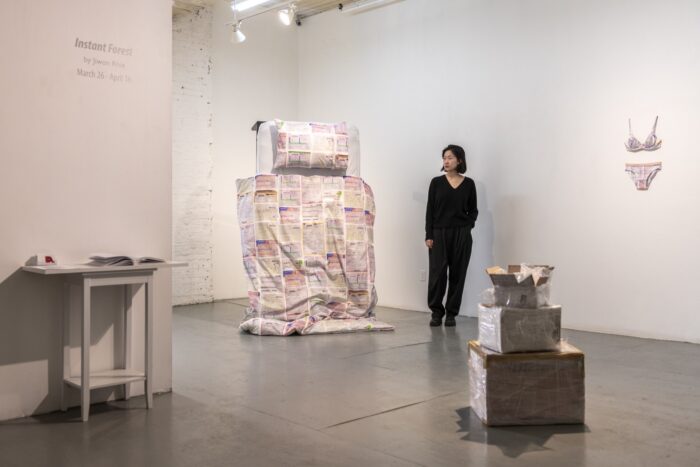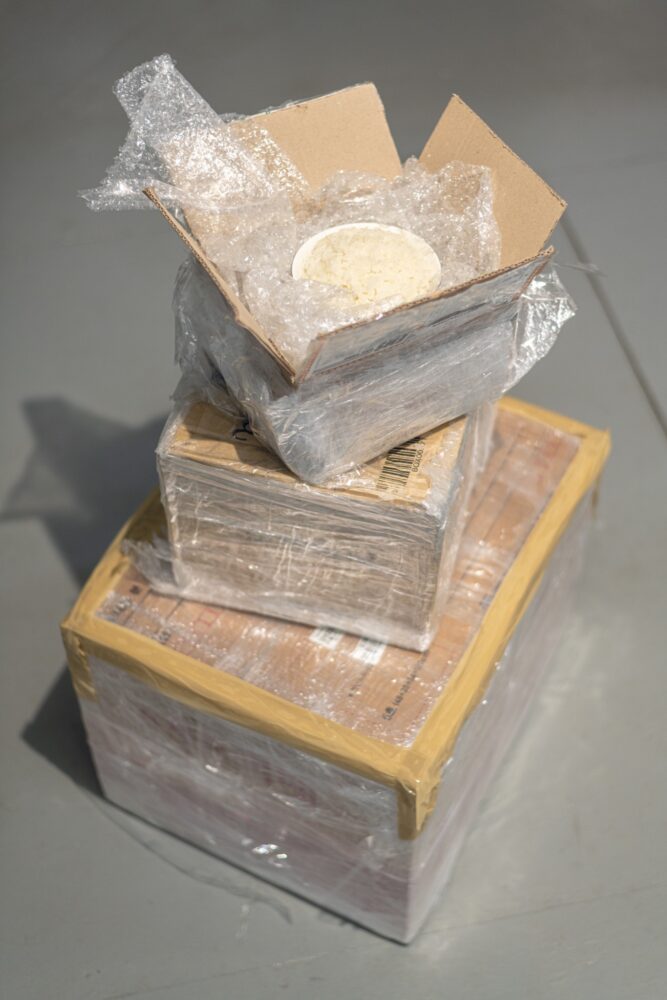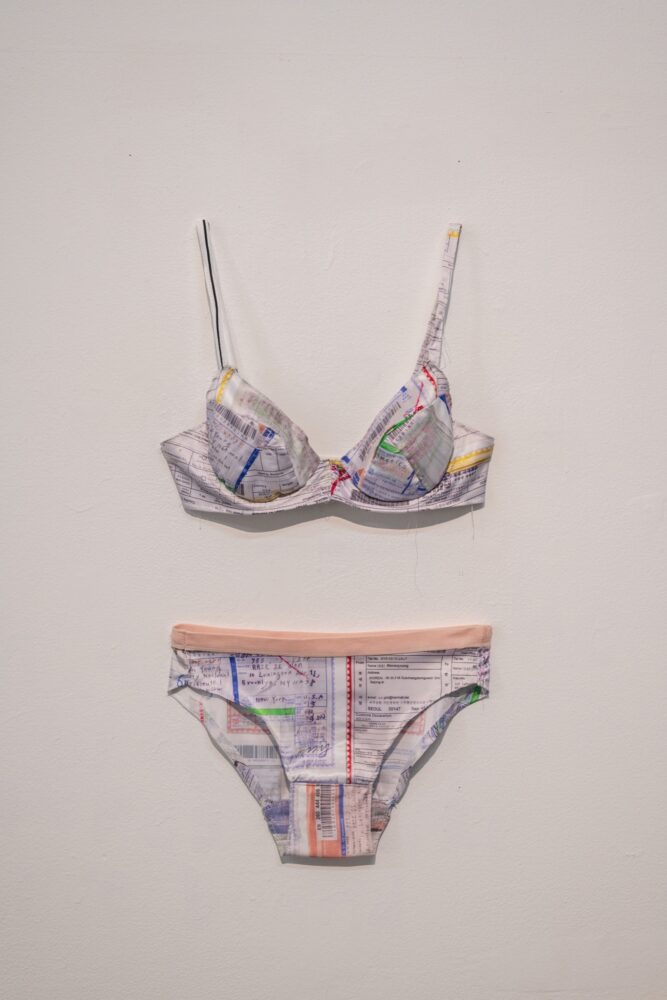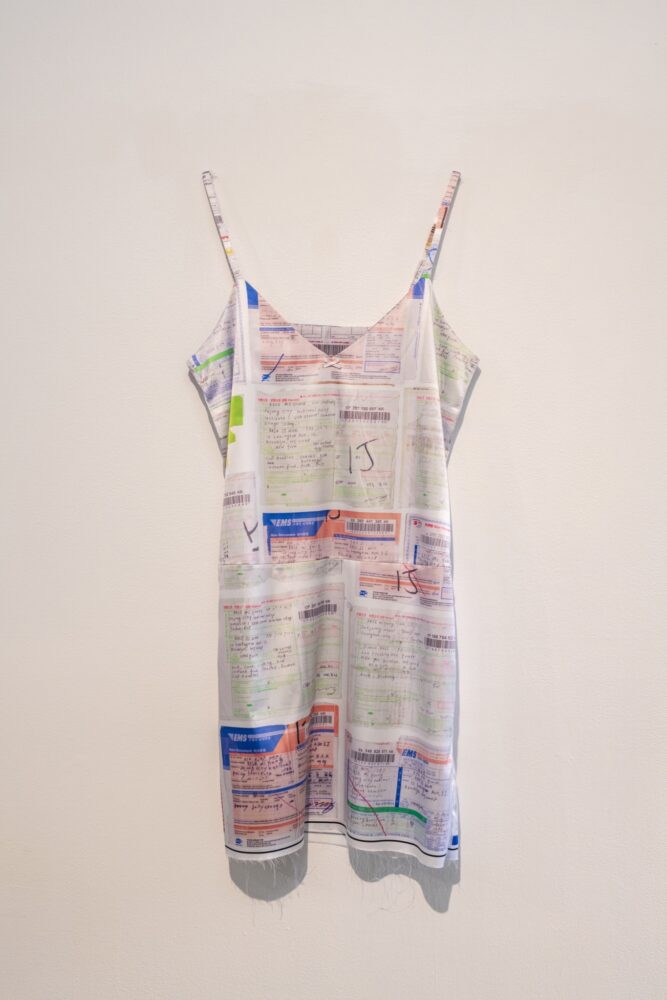
Jiwon Rhie – Instant Forest Exhibition Review
The exhibition was on view March 26 – April 19, 2021, at NARS Project Space
Photographs by Kyungjun Lee
The exhibition entitled Instant Forest poetically embodied the act of being connected, even if from across the ocean. Reality across hemispheres has a different pace, a different day to day. Communicating from across the oceans and continents, staying in touch, requires a special kind of bond, a special kind of friendship and love. Perhaps one spiritual in nature.

On view were recently created artworks (2021) Jiwon Rhie conceptualized and conceived during her residency at NARS Foundation. The artist had been collecting customs forms from Korea for four years and decided to develop a series of sculptures and installations using shipping materials, covered with copies of the forms, as we see in Care Package from Korea (2021). These stacked package boxes are wrapped by box tapes, layered multiple times until the box’s surface fades. Within the overly protected boxes is nothing more exclusive than a bowl of rice, a staple food in Korea, that the artist’s mother sends to her child. Instant Forest, the title of the exhibition, comes from a failed Google translation of a shipping package from Rhie’s mother containing instant soup.

When entering the exhibition the viewer was confronted with Physically Distanced Intimacy (2021)—a bed standing up, defying gravity, with its sheets and duvet cover made out of collaged and printed package stamps, and international shipping custom forms. Similar to Sarah Lucas’ Au Naturel (1994), Jiwon Rhie uses a mattress as a direct symbol of intimacy, she re-purposes the mattress to show her longing and lost dreams, her pandemic diary. The “packages connect [Rhie] and [her] parents materially, sleep makes impossible contact possible through the unconscious.” These are thoughts, prayers, and bodily discomfort associated with being displaced and feeling homesick. Even when relocating, to a new continent, seeking for better life and career, was simply and purely one’s choice. As Jiwon Rhie puts it: “This stand-up bed installation started from the idea of connecting distant places and the visualization of physically distanced intimacy… Packages from the home country are one way of exchanging affection and care. By installing the bed, our most intimate furniture, in an upright position, allows the image to become more reachable at eye level yet withheld from its primary activity of intimacy.”


Rhie’s collection of customs forms finds its medium in objects of everyday use, objects as intimate as a bed, care package, and undergarments. In artworks, Custom Forms Under Garment_Bra and Panty (2021) and Forms Under Garment_Slip Dress (2021) the artist applies the custom forms from home country to undergarments, as venerable objects that protect and touch the body. These objects are a love letter, a longing for connection, and a special bond, a mother cord, even if idiomatic, with one’s mother, primary caregiver, or anyone person (or more) who showed us the world. The way Rhie re-purposes custom forms reminds me of my mother’s stamp collection, looking at her meticulously cutting the stamps out, soaking, dissolving the adhesive, delicately disconnecting the stamp from the envelope, leaving them to dry, then cataloging. Observing my mother’s care and dedication made me learn a lot about her character, longings, and lost dreams.
How can this sense of bond and intimacy emerge between strangers? Sheetal Prajapati is another artist who when referring to the hypothesis of her conceptual participatory work entitled Closer (2016), talks about how “the nuances and details of [a] story (what we share with others) are connected to our relationship with that person”. Prajapati’s conclusion refers to strangers and human connection: “In this work, I was interested in thinking about the ways we are always living in a state of intimate potential and that there is space for people with no prior relationship to relate, to create a moment of connection or intimacy (which I believe inherently has value in the quality of living) in sharing their life experiences.”
Rhie’s earlier conceptual pieces from Defined Boundaries (2018) series, forming three-dimensional drawings made of steel, create a screen between people as a physical object. There the artist forces physical distance between two people. A distance that could also be seen as a possible connection, if we think of computer screens and how they help us communicate with our loved ones. Especially now during the pandemic, this is the only intimacy we get. The screen you can always turn off, and find yourself again, as Legacy Russel puts it in Glitch Feminism: A Manifesto, AFK (Away From Keyboard). Today, AFK means solitude, without people physically around, because the global pandemic has invaded our personal space, leaving it empty. The distance between a mother and her migrant child is measured only by the length of the miles a care package has to go through. The weight of the package, the shipping cost. The footwork the mother had to do in order to assemble, and the lines she had to wait in to send the package. All to care for their child.
Article by Klaudia Ofwona Draber

